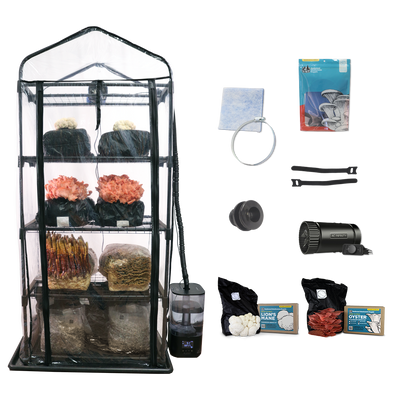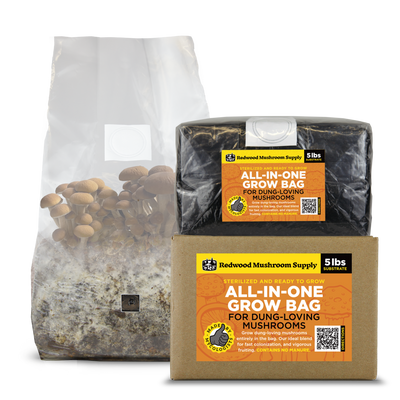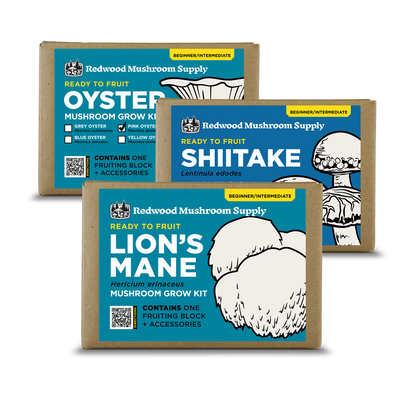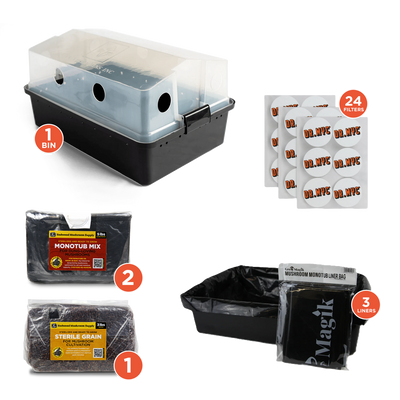Whether you're a chef looking for novel ingredients, a gardener looking for a new challenge, or simply endlessly curious about fungi, cultivating mushrooms can be a fun and rewarding. This article is the first in a series of detailed guides that explain and demystify the mushroom cultivation process. If there are any terms that you are unfamiliar with, feel free to check out the glossary located at the bottom of this article.
Mushroom Cultivation Can Be Easy

Mushroom cultivation can be easier than baking a cake, or it can be more complex than a graduate-level microbiology course. It all depends on how deep down the rabbit hole you choose to go. But one thing is certain: there’s something in it for anyone interested at any level of involvement. No matter where you find yourself, you can cultivate fresh, delicious mushrooms with your own two hands, often with resources you already have.
While you could learn the basics of mushroom cultivation in a single YouTube video, our guides are aimed at those who seek a deeper understanding of mushroom cultivation. They provide the basic theory behind the dos and don’ts of growing mushrooms, along with the practical knowledge you need to know. By understanding the theory, we believe you can then adapt cultivation techniques to your local conditions and troubleshoot any problems you may encounter in the process.
If you’re looking to learn about a specific part of the cultivation process, feel free to skip directly to our more detailed articles on the following sections:
- Introduction to Substrates
- Introduction to Pasteurization and Sterilization
- Introduction to Inoculation
- Introduction to Incubation
-
Introduction To Fruiting
Understanding Mushrooms and Mycelium
“If you wish to grow mushrooms, you must first think like a mushroom”
- Agaricus bisporus, 1643, Paris, France.

While humans have been cultivating plants for thousands of years, the cultivation of mushrooms is a relatively new advancement of human ingenuity. Their cryptic life cycle has eluded our understanding for millennia and has always fostered an aura of mystery. Even today, many people lack knowledge regarding the basic biology and life cycle of mushrooms in nature, let alone in cultivation.
This is likely because the mushrooms we are familiar with are only the tip of the iceberg compared to the rest of the organism, which is often hidden from plain sight. Indeed, mushrooms are only the reproductive structure of a more significant and longer-lived part of the organism known as mycelium.
Mycelium is the spider web-like network of fine white threads that can be seen in rich soils, woody debris, leaf litter, and other decomposing organic materials. It is frequently compared to the “roots” of a mushroom due to its branching form, which connects to the base of the mushroom stem.
It is this branching network of mycelium that is the true workhorse of the organism. It is the actual “body” of the fungus, while mushrooms are merely the “fruits” it produces. This is why those who wish to grow mushrooms must first learn to grow and care for mycelium, before reaping its fruits.
While the end goal of mycelium is to produce mushrooms, its main job is to decompose and consume organic materials. To do this, mycelium penetrates, engulfs, and colonizes substrates, releasing enzymes into it as part of its digestive process.
Once broken down into bioavailable components, the mycelium absorbs the nutrients, assimilates them, and utilizes them to fuel its growth. When the conditions are right, this mycelium produces the fleshy reproductive structures we call mushrooms.

The job of the mushroom fruiting body is to produce microscopic dust-like spores that travel in the air. These spores are often compared to “seeds” since they serve a similar function of spreading the offspring to new locations. When these spores reach an adequate habitat for them to grow, they germinate and form a new network of mycelium. If everything goes well, this mycelium will produce mushrooms, and the cycle will repeat.
The Cultivation Cycle
While mushroom cultivation can be complex, our introductory series attempts to teach you the most basic and easy methods to do this at home successfully. We’ve broken it down into six detailed articles that break down the most critical components of mushroom cultivation.
Before giving you an introduction to each of these critical components, it’s essential to get the big picture of how each of these steps is related. This is outlined below.
Basic Steps Of Mushroom Cultivation

1. Substrate Selection and Preparation
The substrate is the bulk material that acts as the primary food source for your fungi. In most cases, substrates are composed of straw or sawdust, but other materials, like agricultural byproducts, can also be used. Substrates must be nutritious, free of anti-fungal components, and adequately prepared for your fungi to consume them. Substrates can also be supplemented with nutrient-rich materials to improve the yields of your grow.
You can check out our Introduction to Substrates article here.
2. Pasteurization/Sterilization

Before you can inoculate your substrate with a fungal culture, it is essential to treat it by pasteurization or sterilization. These processes remove harmful microorganisms that can impede the growth of your mycelium after inoculation. While we provide a brief summary below, you can check out our complete article here.
-
Pasteurization
Pasteurization is the least intensive of this duo, as it removes a majority, but not all, of the microorganisms present on a substrate. It typically aims to remove the vast majority of harmful organisms while leaving some beneficial microorganisms. The benefits of pasteurized substrates (as opposed to sterilized) are that they can be processed in open-air spaces and don’t require sterile laboratory-like conditions.
-
Sterilization
Sterilization, on the other hand, aims to remove every speck of life found on the substrate. This is only achieved by treating the substrate with high quantities of heat and pressure for long periods of time. This is typically done in a pressure cooker or autoclave. Steaming for long periods of time (12-24hrs) can also achieve similar results. Sterilization is primarily helpful for supplemented substrates and for the production of spawn.
3. Inoculation

Once your substrate has been properly treated, it is time to inoculate it with fungal mycelium. Inoculation is the term used to describe the act of introducing a fungal culture into a new growth medium. In our in-depth article, we break inoculation into two basic types.
-
Non-sterile inoculation is recommended for beginners. It can be performed in almost any environment, even outdoors. This method is suitable for unsupplemented substrates, such as plain sawdust or straw, which have lower nutrient levels and, therefore, pose a lower risk of contamination. Examples of non-sterile inoculation include inoculating unsupplemented substrates with spawn, using liquid culture syringes to inoculate sterilized grains, and inoculating logs (we will cover log-inoculation in a future article).
- Sterile and aseptic inoculation is required for inoculating supplemented substrates, spawn, agar, and liquid cultures. These materials are highly susceptible to contamination due to their rich nutrient content. This method involves using a laminar flow hood or still air box to create a sterile environment and the employment of aseptic techniques to prevent contamination.
A Note On Spawn: Spawn is one of the most critical components of mushroom cultivation, as it is the source of the fungal culture used in cultivation. Spawn is simply a clean culture of fungal mycelium, typically grown on material like grain or sawdust. While you can’t usually find it at a local store, it can be easily found online or from a local producer in your area. If desired, it can also be made at home.
Check out our Introduction To Inoculation article here to learn all about it.
4. Incubation

Incubation is the period in mushroom cultivation that begins right after inoculation and ends when the substrate is fully colonized by mycelium. It is a crucial phase where the mycelium spreads throughout the substrate, establishing itself before the fruiting stage. The duration of incubation can vary significantly, ranging from weeks to months, depending on many factors.
During incubation, the primary role of the grower is to provide optimal conditions for the mycelium to flourish. This primarily involves maintaining a suitable temperature range for the specific mushroom species being cultivated.
You can find our in-depth guide on incubation here.
5. Fruiting

The fruiting stage is the culmination of the mushroom cultivation process, marking the transition from mycelial growth to the production of the actual mushrooms. It's the stage where the cultivator's efforts are rewarded with a harvest of delicious or medicinal fungi.
The fruiting stage is initiated once the mycelium has fully colonized the substrate during the incubation period. At this point, the mycelium has depleted most available nutrients and has stored sufficient energy reserves to support forming fruiting bodies. At this stage, growers must provide conditions with adequate temperatures, high humidity, and high quantities of fresh air.
Check out our in-depth guide on fruiting here.
Conclusion
If you’re interested in learning more, check out the other articles on our blog and those linked. Feel free to reach out if you have any questions. Happy growing :)
Glossary
Below is a list of words and their definitions commonly used in mushroom cultivation.
Mycelium: Mycelium is the fungal web-like network of cells that produces mushrooms. Cultivating mycelium is a preliminary step to growing mushrooms.
Mushrooms: These are the actual fleshy structures we are familiar with. They are often referred to as fruiting bodies to distinguish them from the entire fungus, which is often colloquially referred to as mushrooms.
Substrate: A substrate is a material that provides food and habitat for the fungal mycelium. It typically must undergo pasteurization or sterilization in the context of cultivation.
Pasteurization: The treatment of a raw substrate, usually by heating, which significantly reduces the quantities of harmful microorganisms while preserving some beneficial ones.
Sterilization: The treatment of a raw substrate with high quantities of heat and pressure to eliminate all microorganisms. It is more intensive than pasteurization.
Carbon: Carbon is the building block of all living organisms. It is the primary energy source for fungi and is the bulk component of their diet.
Bulk Substrates: Materials such as straw or sawdust provide the bulk material that a final substrate is composed of.
Organic Matter: When we talk about organic materials or organic matter, we are not talking about USDA organic or any other form of certification. Aside from the certification, organic refers to something carbon-based of biological origin. Organic materials include wood, sawdust, leaves, straw, and almost anything you can think of. Our bodies are technically composed of organic materials. They differ from inorganic materials like plastics, rocks, metals, and minerals.
Supplementation: Supplementation involves adding nutrient-rich materials, like bran or soybean hull, to a substrate. This can improve yield but also increases the risk of contamination.
Biological Efficiency (BE): Biological efficiency is a term utilized to describe how effective the fungi were at transforming the substrate into mushroom fruiting bodies. It is displayed as a ratio or percentage that represents the original weight of the substrate compared to the final yield of mushrooms. For example, if 1 kg of substrate yields 1 kg of mushrooms, you have a 1:1, or 100%, Biological Efficiency.
Colonization: This is the act of mycelium growing and “taking over” a substrate. When a substrate has been fully engulfed by mycelium, it is “fully colonized”.
Spawn: Spawn is a material, such as grain or sawdust, that has been colonized by mycelium and is used to inoculate a substrate.
Inoculation: Introducing a fungal culture, such as spawn, to a substrate. The source of the fungal culture is known as an “inoculum.” Different inoculum types include agar, liquid culture, spores, or spawn.
Incubation: The period after inoculation where mycelium is left to colonize the substrate.
Fruiting: The stage where mushrooms develop from the mycelium, which usually requires adequate temperatures, fresh air exchange, and plenty of humidity.
Pins or primordia: Tiny "baby" mushrooms that indicate the start of the fruiting stage.
Contamination: The presence of unwanted microorganisms, such as bacteria or mold, that can compete with or harm the mushroom mycelium.
Fresh Air Exchange (FAE): The process of replenishing air in a fruiting chamber to provide oxygen and reduce carbon dioxide buildup..
Relative Humidity (RH): The amount of moisture in the air, which is crucial for the formation of fruiting bodies.




